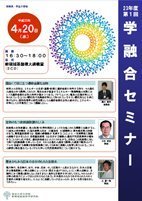AY2011 1st Gakuyugo Seminar
- Date&Time:
- Apr 20, 2011 16:30~18:00
- Venue:
- Large Lecture Room (2C0), New Frontier Science Bldg.

Interesting and useful transition metal compounds
Associate Professor Takashi Mizokawa
During the course of evolution, life on earth has acquired the ability to use transition metals for the generation, transport, and storage of energy. Transition metal compounds are also being used to address the energy and environmental problems that society faces today. I would like to discuss the interest of transition metal compounds as a research subject in solid state physics and their potential as energy materials, using cobalt oxide known as a cathode material for lithium ion batteries and titanium oxide known as a photocatalyst material as examples.

Radiation protection mechanisms in living organisms
Professor Keishi Mitani
The biological effects of radiation are characterized by 1) non-specificity of symptoms, 2) existence of a latent period, 3) intractability, 4) imperceptibility at the time of exposure, compared to disorders caused by other physical and chemical factors. 4) imperceptibility at the time of exposure. In high-dose radiation, tissue dysfunction occurs after a certain period of time due to the death of tissue stem cells, and in low-dose radiation, the risk of cancer, aging, and development of genetic diseases increases due to an increase in the rate of genetic mutation in surviving cells. Living organisms have a variety of protective mechanisms against radiation, which are thought to be the result of mechanisms acquired during evolution to avoid problems in replication and transcription that also function effectively against radiation damage. In this presentation, I will give an overview of these mechanisms and introduce our current mutation research using medaka.

Japan's Distorted Ecosystem in Historical Perspective
Professor Seiichiro Tsuji
In the course of the Jomon, Yayoi, Ancient, Medieval, Early Modern, and Modern eras, Japan's ecosystems have undergone major changes due to environmental changes and human activities. In particular, human activities have created a variety of artificial ecosystems that are not in harmony with the environment from an ecological point of view. Many of these were brought about by the political power of the time. I would like to draw out the reality of these ecosystems that have been distorted throughout Japanese history, and how they should be healed.
*The contents of this page were developed based on a machine translation.

